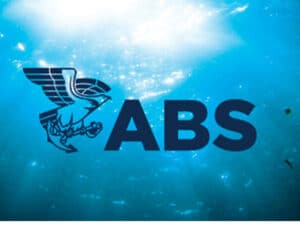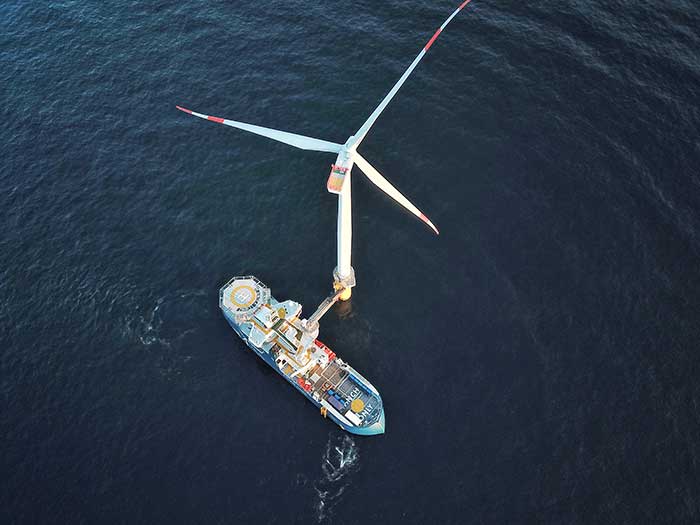
CBP Jones Act proposals could have big impact on U.S. offshore
Written by Marine Log Staff
SOV connected to wind turbine
On October 23, 2019, U.S. Customs and Border Protection proposed substantial changes to its interpretations of the Jones Act that will affect both the offshore oil and gas and offshore wind industries. The Jones Act is a key driver in how offshore structures are constructed and dismantled and so its interpretation is critical to both operational planning and cost analyses. Public comments are due on the proposed changes by November 22, 2019.
The latest CBP proposals are framed in language that is less than easy to to come to grips with but, fortunately, in the latest Maritime Fedwatch from law firm Winston & Strawn, partner Charlie Papavizas cuts through some of the clutter.
Here’s what Papavizas writes:

The Jones Act restricts the transportation of “merchandise” between two “points in the United States” to qualified U.S.-flag vessels owned and operated by U.S. citizens absent an exception. Similar laws apply to the transportation of “passengers” as well as dredging, fishing and towing in defined U.S. waters. A “point in the United States” can include any man-made object, such as a drill rig, attached permanently or temporarily to the U.S. outer continental shelf for defined purposes.
CBP interprets the application of the Jones Act to operational scenarios by providing rulings to interested persons which are then made publicly available on CBP’s web site. The October 23 proposal would modify a number of Jones Act-related rulings going back to 1976 issued in connection with offshore oil and gas projects focusing on the meaning of “vessel equipment” and vessel movements incidental to lifting operations.
CBP has long considered “vessel equipment” not to be “merchandise” and therefore could be transported by a foreign vessel between points in the United States. The original definition utilized by CBP of “vessel equipment” is a 1939 definition providing that “vessel equipment” are “portable articles necessary and appropriate for the navigation, operation or maintenance of the vessel and for the comfort and safety of the persons on board . . .”.
Commencing in 1976, CBP issued a number of rulings focusing on whether items were necessary for the “mission of the vessel” as a gloss on the concept of being “necessary and appropriate for the operation of the vessel.” Subsequent rulings also focused on whether the item was “used on or from” the transporting vessel, whether the employment of items was “foreseeable,” “incidental” or “de minimis” (with unforeseeable, incidental or de minimis deployments weighing in favor of an item being “equipment”).
Under these formulations, CBP issued rulings to the effect that a variety of items utilized in oil and gas operations, such as risers and pipe connectors, were “vessel equipment” primarily under the interpretation that they were necessary for the “mission of the vessel” and therefore could be transported from a U.S. port to a U.S. “point” and installed by a foreign vessel.
These rulings became particularly controversial in 2009 when CBP first issued, and then withdrew, a ruling to the effect that a sub-sea assembly known as a “Christmas tree” was “vessel equipment.” CBP then proposed to revoke or modify a whole series of “vessel equipment” rulings, but the public opposition was substantial and CBP eventually withdrew that notice. Under that proposal, the term “vessel equipment” would have been very narrowing defined.
Then in early 2017, CBP made a similar proposal, which was again opposed by a broad cross-section of interests and was again withdrawn. That withdrawal led to federal litigation in the U.S. District Court for the District of Columbia which remains pending.
The October 23 proposal revisits much of the 2009 and 2017 proposals focusing largely on the same “vessel equipment” rulings slated for revocation or modification. The more recent notice would expressly do away with the various accumulated rationales for prior rulings including “mission of the vessel,” “foreseeable,” “incidental” and “de minimis.”
In place of the existing rationales, CBP proposes to retain the 1939 definition as the basis for its interpretations and add that “vessel equipment” means items “necessary and appropriate for the vessel” “to include, inter alia, those items that aid in the installation, inspection, repair, maintenance, surveying, positioning, modification, construction, decommissioning, drilling, completion, workover, abandonment or similar activities or operations of wells, seafloor or subsea infrastructure, flowlines, and surface production facilities.”
CBP further “emphasizes that the fact that an item is returned to and departs with the vessel after an operation is completed, and is not left behind on the seabed, is a factor that weighs in favor of an item being classified as vessel equipment, but is not a determinative factor.”
In large measure, the most recent proposal leaves the specific applications of what “vessel equipment” means to future rulings. For example, in its modification of the original 1976 ruling, CBP leaves open the issue of whether tools used in connection with underwater repairs are “merchandise” or “vessel equipment” because such determination “depends upon the nature of the item and the facts associated with the operation of the vessel.”
In connection with its new proposed interpretation, CBP does make clear that there is no change being proposed to its long-standing interpretation that the laying of cable or pipe between two points in the United States can be done by a foreign vessel.
In addition, CBP addresses for the first time among the proposed 2009/2017/2019 notices to address lifting operations offshore. CBP had previously determined that a short vessel movement by a crane vessel as part of the overall transportation of a topside or other item from a U.S. port to an offshore U.S. point had to be accomplished by a qualified U.S.-flag vessel. Movements of a vessel’s crane when laden without any vessel movement other than a rotation of the vessel on its axis, however, was exempt from this application.
These interpretations caused significant safety concerns. The lack of heavy lift capacity in the qualified Jones Act fleet necessitated the use of foreign vessels to minimize the number of lifting operations, and lifting operations are prohibited within a safety zone around subsea installations thereby necessitating some incidental lifting vessel movement.
In the October 23 notice, CBP proposes to resolve this problem by defining “lifting operations” not to be “transportation of merchandise.” Such “lifting operations” would include “certain lateral movements” of the vessel in connection with the lifting operation.
Although both the prior 2009 and 2017 notices resulted in an extension of the comment period, such an extension cannot be assumed and so all public comments must be submitted by November 22, 2019.




